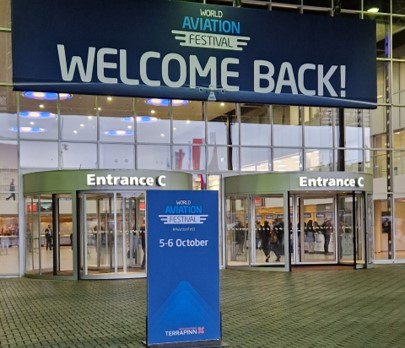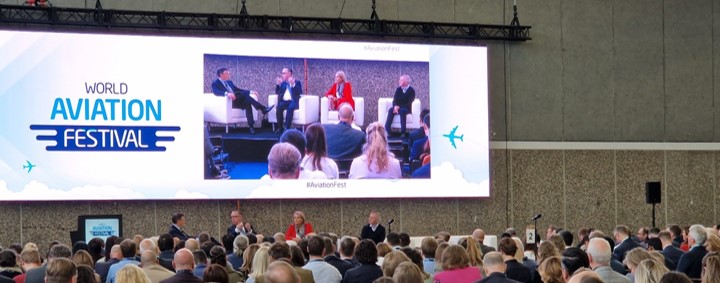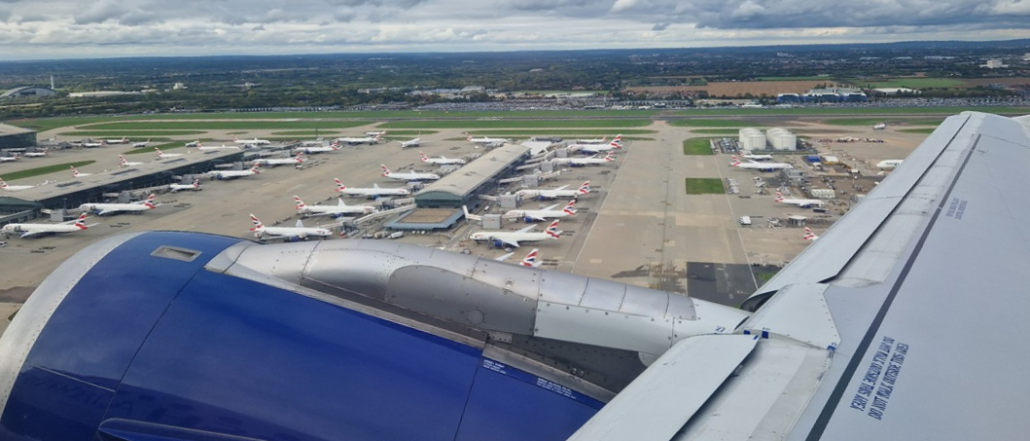Passenger Experience: looking back at the World Aviation Festival

Last week I had the pleasure of chairing the Passenger Experience tracks at the World Aviation Festival in Amsterdam. For anyone who wasn’t able to get there but is interested in the themes that emerged, I’ve made a few notes here.
Spoiler alert: there are no scoops or exclusives, I’m not an investigate journalist. But, for colleagues I work with in aviation around the world these notes are just my take on what I heard. I didn’t see every session and my reflections are, by definition, based on interviewees, panellists and presenters from aviation organisations who chose to be there. That said, the World Aviation Festival is a heavyweight event, always attracting CEOs and other senior leaders of the most significant airlines, airports, industry bodies, tech companies and suppliers from across the globe.
In summary…
It’s a complicated picture but casting one eye to the future, things are looking up and the mood in the room was an optimistic one. Routes are being added, the sustainability agenda is very front-of-mind and this Summers’ bookings and load factors, in the northern hemisphere at least, showed there is still a strong desire to travel.
Looking at the more current challenges we’ve seen lately, they are being overcome but a degree of uncertainty remains with some airlines and airports faring better than others. There was no getting away though, from the fact that the last few months have stretched passenger confidence and loyalty, staff morale and stakeholder relationships to near breaking point.
At the event, airline and airport CEOs reflected on how tough it had been for their staff and for customers. Just when it looked like 2022 would be a year of relatively straightforward recovery, we have multiple changes as pandemic rules were relaxed, the Summer’s schedule caps, the surging cost of fuel, the workforce vacancies despite low unemployment and the rising cost of living. Add into the mix limited production of Sustainable Aviation Fuels, the closure of Russian airspace to airlines flying to Asia and a loss of expertise from the sector, it’s easy to see why it’s been an ‘interesting’ period. Investors, Boards and passengers like stability and certainty, both of which have been scarce commodities of late.
Looking ahead though, it is an industry that is very well aware of the responsibilities it has in Society. As far as becoming carbon-positive is concerned there is a definite shift from the reactive (such as offering a passenger to offset their emissions) to the proactive, such as testing electric vehicles for airport operations and test flights with Sustainable Aviation Fuels.
The industry is also acutely aware that its customers have a choice and a voice and both have a big impact on the financials. Those choices now do not just include other airlines but whether to fly at all. Nonetheless, despite still hurting from the last three years’ ups and downs, it is resolutely determined to make flying in the future more enjoyable, more sustainable and more commercially rewarding.
Passengers are people, not PNRs or data points…
A carrier with millions of passengers each year is creating millions of stories that get shared. They sit in the memory, influencing future buying behaviour. The term ‘customer experience’ is over-used but this year more than any before, industry leaders spoke about how important empathy is in securing passengers’ loyalty, advocacy and spend. There was a reflective honesty about the material impact the last few months have had on passengers, employees and by extension, the brand.
As an aside, research by Watermark Consulting shows that investors recognise the role better experiences play. They report that where North American airlines had good customer satisfaction scores, the rate at which their stock price grew by far outstripped the growth rate of airlines with poor customer scores. A direct correlation to underline how important it is to get right.
Indeed, Sheik Aimen bin Ahmed Al Hosni, CEO of Oman Airports, captured the essence of their work as “It’s all about the human touch”. Paul Griffiths, CEO at Dubai Airport, had a similar perspective: “We’re not in the business of airport infrastructure and operations, we’re in the hospitality business”. The challenge then is to organise all the moving parts so they create an intended experience that leads to the right memories being held and the right stories being told.

Whose fault is it anyway?…
While some airlines and airports came through the Summer period relatively unscathed, others didn’t cover themselves in glory. And so, in certain areas, the blame game continues and it’s often very public.
The pandemic forced airlines, airports, partners and regulatory bodies to work closer together than ever before. New relationships were forged and which continue, although this Summer’s challenges prised open old rifts. Lessons have been learned, which includes the absolute importance of collaboration and that the earlier the communication between stakeholders the better, though it shouldn’t take a pandemic to come to that conclusion.
A tough job, a tough crowd…
Obviously, the industry has taken some big hits over the last few years. Its passengers lost confidence. Its employees lost their jobs. Its airlines, airports and ground handlers all lost expertise. Stakeholder relationships lost their impact. Credit ratings lost their ability to hedge fuel costs at a better rate. Working in the aviation sector lost its “wow” factor. The impact on passengers and employees was not glossed over, far from it.
There was a genuine regret over the anxiety, frustration and disruption many travellers had endured. There was an acknowledgment too of the pressure so many front-line and back-office colleagues had been under. No-one wants to wake up in the morning and go to work knowing they are going to have a bad day, a long shift full of frayed tempers and uncertainty.
There’s no denying that many passengers, myself included, had experiences they would not want to repeat even if the cost of the flight was free. But those staff who kept their heads, kept turning up for work, mucking in with jobs outside their usual remit and working hours and who kept smiling throughout should be commended. They created many positive experiences that should be (and are being) celebrated. I sincerely hope that a return to healthier revenue streams doesn’t allow complacency to creep in, to take customers and employees for granted, however unintended that may be.
On the labour market, as in other industries, the challenges remain to find not just enough people but with the right attitude and expertise too. It’s not hard to see why someone earning a basic wage would rather become a barista in a coffee shop than be trained for weeks and put through security checks only to end up out on the ramp at 4am in the driving rain.
Digital when it can be, human when it needs to be…
The people-centric theme continued, even around the focus on all-things digital. Advances in technology are still moving at a fast pace, sometimes too fast for legacy systems and booking engines to keep up. There was no shortage of start-ups demonstrating the next generation of use cases for AI, the Metaverse and biometrics.
For sure, digitisation can make things easier for passengers (genuinely, more ‘seamless and personalised’?) while bringing process costs down and supporting ancillary revenues for the airline. Technology has some exciting implications for providing assistance to passengers who have a disability or who simply find air travel prohibitively challenging and/or overwhelming.
But, the repeated caveat was that it should always recognise there is a human being on the other end of it; technology should be used to make experiences more reliable, easier and they should evoke the emotions that create value, not deploy it just because it’s a shiny new piece of tech.
Lufthansa talked proudly and passionately about being one of the airlines who has carved out an innovation lab as a separate entity to the parent company. It ensures new tech delivers value both to passengers and the airline and routinely has to demonstrate the beneficial ROI.

Certainty with flexibility as standard…
Passengers have always expected – and needed – certainty about their travel arrangements. Should it turn to custard and things go off-schedule, they need empathy, information and support. The pandemic, and latterly social media pictures of queues at border control and baggage mountains, did little to provide any reassurance in that respect.
It is perhaps no surprise that when it comes to describing what experiences should be like, the most often mentioned characteristic was “predictability”. Yes, it’s about getting the basics done well every time but it’s also about managing expectations and being better at providing information, options and control when things don’t go to plan. It sounds easy and obvious yet the one complaint passengers will still have is the lack of information and support when they need it most. We’re human beings, we draw comfort if we feel someone is looking out for us but our frustration builds if we feel we’re being ignored or being treated with contempt. Creating the proverbial ‘one version of the truth’ for all colleagues and customers is getting easier but is still heavily reliant on connecting the gaps between a multiplicity of systems.
So when it comes to travel we like certainty. Somewhat ironically therefore, the other key expectation passengers have more now than ever before is flexibility. Plans change, stuff happens. To get it right is a demonstration of what we mean by a ‘personalised’ experience – not just suggesting alternative revenue-generating opportunities but making the passenger feel heard, that someone is already trying to help them resolve their issue. It’s about creating an intentional experience every time and if that includes service recovery efforts, there’s research to show that a well-handled problem can create even more loyal passengers than if they had no problem at all.
An urgency around sustainability…
Turning back to the future, it was appropriate the event was held in Amsterdam. NS, the Dutch rail operator sets a good example and runs its trains on electricity generated from the wind farms it invested in. Air Canada for example, is among the airlines putting in orders for electric aircraft. Other airlines are investing in the upstream production of Sustainable Aviation Fuels rather than wait for oil companies to be given government incentives. And there are many other initiatives around such as a recent easyJet trial with Bristol airport where all the ground handling vehicles were electric.
I sensed the narrative on sustainability was changing. In recent years the focus has been to educate passengers and encourage them to make payments to offset their carbon emissions. This year, it was clear the industry wants to get on with it. There is more talk – and, in fairness, action – around integrating with other sustainable transport systems to help get people to and from the airport.
And while government support is needed to stimulate greater production of Sustainable Aviation Fuel, some airlines like United are saying ‘hold my beer’; they are not waiting for the wheels of bureaucracy to turn. Instead, they are shifting the focus from taking plant-a-tree offset contributions to investing directly in the SAF supply chain themselves and in electric flight. British Airways is among the airlines who have created senior leadership roles specifically to push forward on the sustainability agenda.
In the background, airlines will watch passenger behaviour closely – many want easy (that word ‘seamless’ pops up again here) ways to offset their flight’s emissions but they also want confidence that any contribution is going to a meaningful cause. Many of you will know Shashank Nigam, CEO of SimpliFlying – he not only hosts a great podcast series about sustainable aviation (check it out here) but he is setting a credible example by cutting back on his own annual flight count.

So…
If my own experiences at Heathrow and Schiphol are anything to go by, it was pretty much as it should be. There are a lot of good people trying really hard to make things better day by day and earn the right to their passengers’ spend, loyalty and advocacy.
The well documented challenges for the aviation industry around the world have not all disappeared. Some old chestnuts that cause niggles and frustration may still rear their head from time to time. But, by improving the collaboration between stakeholders, by seeing the commercial benefits of better experiences and by being proactive on the sustainability agenda, I sensed a genuine urgency from leadership teams to ensure the industry emerges from that as quickly as possible. Not least, for its employees and passengers but, as a result, for the planet, the balance sheet and investors too.
It’s a resilient sector. It’s complex and not perfect but the pride was back as was the determination to forge ahead and make it work.
A final word of huge thanks to Daniel Boyle and the brilliant team at Terrapinn for bringing everyone together and for putting on an engaging and insightful event once more!
Jerry Angrave helps airlines, airports and companies in other sectors define and deliver their Customer Experience Strategy. He is a CCXP, a Certified Customer Experience Professional and wrote “The Journey Mapping Playbook”. Jerry is a member of the British Aviation Group and a member of London Heathrow Airport’s Accessibility Advisory Group.

Leave a Reply
Want to join the discussion?Feel free to contribute!